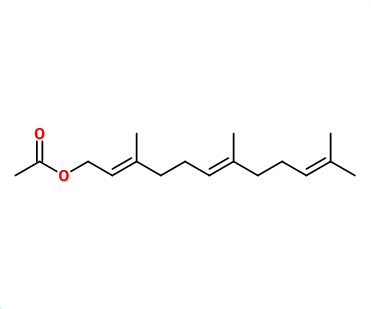Farnesyl acetate
Synthétique
Floral > Light Flowers > Zesty

Crédits photo: ScenTree SAS
Other names :
Farnesol acetate ; Acetic acid farnesyl ester
Volatility :
Heart/Base
Uses in perfumery :
Mainly used to add volume and freshness in white flowers accords.
Natural availability :
Found in Ambrette seed Oil (4%)
Year of discovery :
Data not available.
Other comments :
Price Range :
€€€€
Stability :
Esters may form their corresponding acid through time

Crédits photo: ScenTree SAS
- Molecular formula :
- C17H28O3
- Molecular Weight :
- 264,4 g/mol
- Density :
- 0,91
- Flash Point :
- 110°C
- Fusion Point :
- Donnée indisponible.
- Appearance :
- Colorless liquid
- Log P :
- 6,77
- Boiling Point :
- 325°C
- Detection Threshold :
- Donnée indisponible.
Synthesis route :
The synthesis of Farnesyl acetate is carried out by an esterification reaction between Acetic Acid and Farnesol. This reaction can be catalyzed by the presence of a small amount of a strong acid such as concentrated sulfuric acid. It can also be achieved by thanks to the use of acetic anhydride or chloroacetic acid instead of acetic acid.
Synthesis precursor :
Farnesyl acetate is not a precursor to the synthesis of another compound of olfactory interest.
Isomerism :
Due to the presence of two double bonds in Farnesol, there are four pairs of diastereoisomers of Farnesyl acetate : (E,E), (Z,E), (E,Z), (Z,Z). In perfumery, we use a mix of all those isomers.
- EINECS number :
- 249-689-1
- FEMA number :
- 4213
- JECFA number :
- 1831
- FLAVIS number :
- 09.818
- Allergens :
- This ingredient does not contain any allergen.
- IFRA :
- This ingredient is not restricted
To learn more about IFRA's standards : https://ifrafragrance.org/safe-use/library
ScenTree is solely responsible for the information provided here.
Do you sell any of the raw materials? Would you like to let our users know?
Send an email to fournisseurs@scentree.co to learn about our advertising opportunities.
